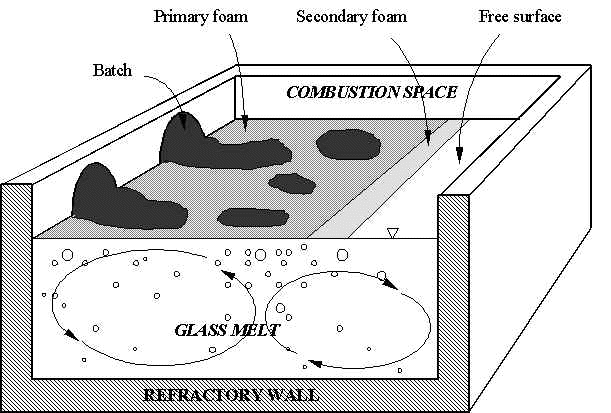
The quality of glass products is degraded if gas bubbles and unfused silica grains remain in the molten glass as it is being pulled out of the furnace. Fewer defects, especially fewer remaining bubbles, has become a major requirement in the new quality standards for many commercial glass products. For example, in the TV glass production, a rate of six bubbles per ton of glass results in 10% rejection rate of the final product, and for new products such as High Definition Television, the quality standards are even more stringent. For automobile glass, the most demanding specification requires that gas bubbles be less than 0.5 mm in diameter for transparency purposes. Moreover, for windshield glass, reducing by half the defect density would increase the profitability by more than 2 millions dollars per year. Consequently, understanding and modeling of the behavior of gases and bubbles in the glass melt are of great interest to the glass industry, both from a technological and an economical viewpoints.
The approach consists of solving the population balance equation for the bubble density function accounting for bubble generation, bubble growth due to changes of pressure as well as diffusion of gases in and out of the bubbles. The number density function f1 is a function of the spatial coordinates (x,y,z) as well as the bubble radius r and the concentration of gases contained in the bubbles, i.e., f1=f1(x,y,z,r,Cb,i). Numerical solution of the intregro-differential governing equation for the number density function is currently being explored with the precious help of Prof. D. Ramkrishna.
This project is closely related to studies on foam dynamics and steady-state thickness as well as to work on radiation heat transfer in semi-transparent media containing gas bubbles.
D. Ramkrishna, 2000. "Population Balances", Academic Press, San Diego, CA.
L. Pilon, A. G. Fedorov, D. Ramkrishna, and R. Viskanta, 2004. Bubble Transport in Three-Dimensional Gravity Driven Flow, Part I. Mathematical Formulation, Journal of Non-Crystalline Solids, Vol. 336, No.2, pp.84-95. doi:10.1016/j.jnoncrysol.2004.01.010
L. Pilon and R. Viskanta, 2004. Bubble Transport in Three-Dimensional Gravity Driven Flow, Part II. Numerical Results, Journal of Non-Crystalline Solids, Vol. 336, No.2, pp.71-83. doi:10.1016/j.jnoncrysol.2004.01.007
L. Pilon and R. Viskanta, 2003. Modified Method of Characteristics for Solving the Population Balance Equation, International Journal for Numerical Methods in Fluids, Vol. 42, pp.1211-1236. doi: 10.1002/fld.586